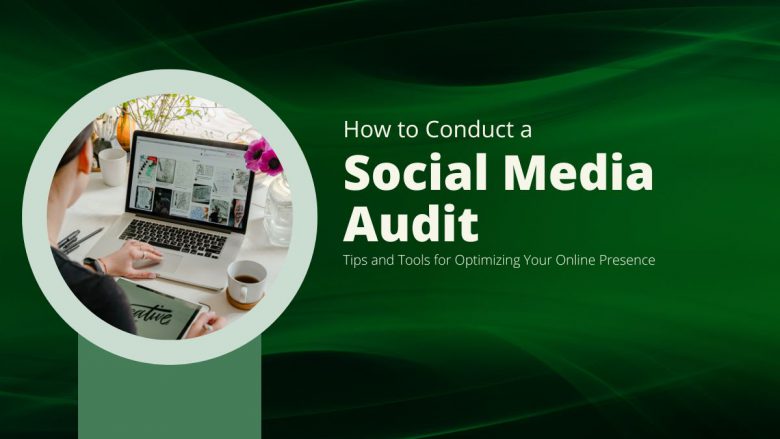
Conducting a social media audit is a crucial step in optimizing your online presence. It allows you to analyze your current social media strategy, identify areas for improvement, and make data-driven decisions to improve your online presence. Here are some tips and tools for conducting a social media audit.
1. Define your goals:
Social media has become an integral part of our lives. Whether it is for personal use or business purposes, we are all connected to social media in some way or another. However, many businesses struggle with defining their goals for social media and end up wasting valuable time and resources on ineffective tactics. To avoid this, it is important to start by defining your goals for social media.
The first step towards achieving success on social media is conducting a thorough Social Media Audit. This involves taking stock of your current presence on various platforms, analyzing your engagement metrics, and identifying areas that need improvement. Once you have a clear understanding of where you stand, you can set specific goals that align with your overall business objectives.
When setting your goals for social media, it is crucial to be specific and measurable.
2. Analyze your current social media presence:
Simply having a social media presence is not enough – you need to make sure that your presence is optimized for success. To do this, it’s crucial to perform a social media audit and analyze your current presence.
The first step in analyzing your social media presence is to take note of which platforms you are currently active on. Are you utilizing all the major platforms or are there some that you have neglected? Depending on your business goals and target audience, certain platforms may be more effective than others. For example, if you’re targeting an older demographic, Facebook may be the best platform for you as opposed to Instagram or TikTok.
3. Analyze your audience:
Simply being present on social media platforms is not enough. Brands must also understand their target audience and tailor their content to meet their interests and behaviors. Conducting a social media audit can help businesses identify who their target audience is, what they like/dislike, and how they interact with the brand.
To start analyzing your audience, first, define who your ideal customer is. Consider demographics such as age range, gender identity, location, income level, etc. Then look at psychographics such as values and beliefs that drive consumer behavior. Once you have identified your target audience, use social media analytics tools such as Facebook Insights or Twitter Analytics to gather data on them. These tools provide insights into engagement rates, follower growth rates, and demographic information about followers.
4. Analyze your competitors:
Social media is a powerful tool for businesses to connect with customers and promote their products or services. However, it can be difficult to stand out in a crowded digital space. That’s where competitor analysis comes in. By analyzing your competitors’ social media presence, you can gain valuable insights into what works and what doesn’t, and use this information to improve your own strategy.
To conduct a social media audit of your competitors, start by identifying who they are. Look at the accounts that have the highest number of followers and engagement within your industry or niche. Next, use social listening tools such as Hootsuite Insights or Sprout Social to track their activity on different platforms. This will allow you to see how often they post, what type of content they share, and how their audience responds.
Once you have this data, you can start analyzing it to identify patterns and trends.
5. Identify areas for improvement:
In today’s digital age, social media has become an essential tool for businesses to connect with their audience. However, simply having a presence on social media isn’t enough. To make the most of your social media strategy, it is crucial to identify areas that need improvement and work towards enhancing them. This is where a Social Media Audit comes into play.
A Social Media Audit involves analyzing your current social media performance and identifying areas where you can improve. The analysis includes various aspects such as engagement rates, follower growth, content quality and consistency, posting times and frequencies, etc. Based on the results of this analysis, you can identify specific areas where you should focus your efforts to enhance your social media strategy further.
6. Develop a new social media strategy:
Developing a new social media strategy can be daunting, but with the right approach, it can lead to significant growth and success for your business. The first step is to conduct a social media audit to identify areas that need improvement. This will help you understand where you stand in terms of your online presence, engagement levels, and overall brand reputation.
Once you’ve conducted an analysis and identified areas for improvement, it’s time to develop a new social media strategy that aligns with your goals. Define your target audience and consider which platforms they use most frequently. From there, create content that resonates with them by addressing their pain points and needs while showcasing the unique value proposition of your brand. Remember to also include calls-to-action (CTAs) in your posts to encourage engagement and drive traffic back to your website.
7. Monitor and adjust:
Social media has become an essential tool for businesses to connect with customers and increase brand awareness. However, simply having a social media presence is not enough to guarantee success. To truly reap the benefits of social media marketing, it’s crucial to have a well-planned and executed strategy in place. And once you’ve implemented your new strategy, it’s equally important to monitor your performance and adjust as necessary.
One effective way to evaluate how well your social media strategy is working is by conducting a social media audit. This involves analyzing all aspects of your social media presence including your profiles, content, engagement metrics, and overall performance. By conducting regular audits using analytics tools like Google Analytics or Hootsuite Insights, you can identify areas that need improvement and make data-driven decisions on how to optimize your approach.
Tools for conducting a social media audit include Google Analytics, Facebook Insights, Twitter Analytics, Hootsuite, and Sprout Social.
Conclusion
Conducting a social media audit is a critical step in optimizing your online presence. By following these tips and leveraging the right tools, you can gather valuable insights, identify areas for improvement, and develop a data-driven social media strategy that engages your target audience and drives business results.



One Comment